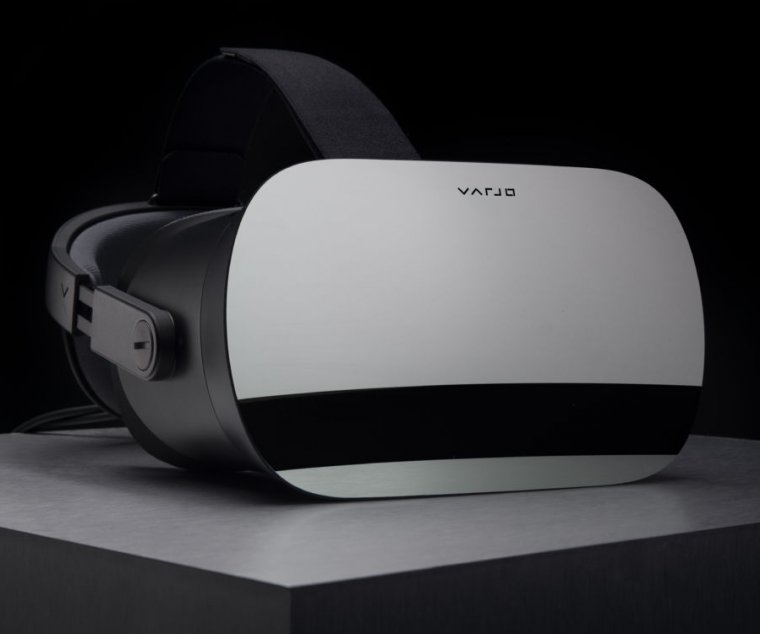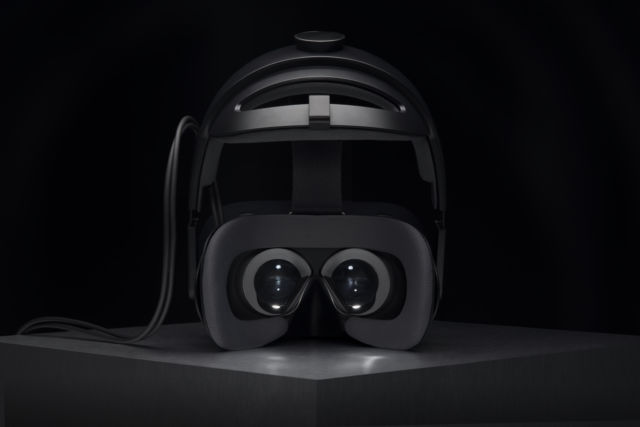
Current virtual reality headsets are pretty good at the "virtual" bit but tend to fall down on the "reality" side of things. It's all too obvious that you're looking at a screen, albeit a screen held very close to your face, and a lot of screens just aren't meant to be looked at that close. The "screen door" effect that breaks the display up into a grid of individual pixels is distracting, and resolutions are low enough that curved lines are noticeably jagged, and fine detail gets lost. Second-generation headsets like the Vive Pro certainly do better than their first-generation counterparts, but they haven't eliminated these shortcomings. Even with eyes as appalling as mine, the human optical systems are clearly higher quality than the VR headsets can satisfy.
But the Varjo VR-1, available to buy today, is the first headset I've used that convincingly provides an image that looks real. The VR-1 puts a 1920×1080 micro-OLED display with some 3,000 pixels per inch (or 60 pixels per degree) slap-bang in the middle of your field of view. It looks like nothing you've ever seen from a headset before: no pixel grid, no jagged lines (nor the anti-aliasing usually used to hide the jaggies), no screen-door effect. The images it displays look every bit as detailed as real life. Varjo calls it the Bionic Display and claims its resolution is about that of the eye, giving it a level of fidelity like nothing else on the market.
Surrounding this screen is a conventional 1440×1600 AMOLED display providing an 87 degree field of view. This showed an image that's much like any other headset. I found the experience of using the VR-1 a little like that of using Microsoft's HoloLens. In the HoloLens, the display has a relatively narrow field of view, so you have to look straight forward to see the images. When looking around, you have to turn your whole head and keep your eyes looking more or less straight ahead if you want to look at something. Otherwise, as soon as you look off to the side, the 3D images disappear.
Bionic Display
The VR-1 isn't anything as severe as that, because the field of view for its standard screen means you can look askance and still see the virtual world around you. Nonetheless, I found myself turning my head more than my eyes when I wanted to look at something, because I wanted to see things through that crystal-clear micro-OLED screen. The larger AMOLED display provided peripheral vision and helped me orient myself, but once you've looked at that Bionic Display with its glorious resolution, everything else just feels so much worse in comparison.
Internally, the image from the Bionic Display is projected onto the larger screen using complex custom optics. The two displays are matched well, so there's no hard outline around the Bionic Display, and colors are closely matched between the two. But there is a slight "halo" around the Bionic Display, making the edge between it and the wide-angle screen slightly visible. It's not distracting in use, but it's there if you're looking for it.
The eye resolution display makes virtual reality feel very different. Using Lockheed Martin's professional Prepar3D flight simulator, I could glance around the cockpit of my F-22, and the text on every button, every knob, and every screen was crisp and readable in a way that just isn't true of lower-resolution headsets. Or take that mainstay of VR demos: watching a giant TV on the wall. This always sounds appealing in theory—you could have the giant TV of your dreams—but the reality is always disappointing. Why? Because your headset simply doesn't have enough pixels to render a 4K TV or even a 1080p one. So while the virtual TV screen may be huge, it's also really low quality, with a much lower resolution than the set you actually own. But not so with the VR-1; the Bionic Display can't cover the full width of a set, so you're looking at a 1920×1080 chunk out of the middle. That's more than enough to accurately draw a 4K resolution TV.
-
This image, supplied by Varjo, shows a zoomed-in crop of an aircraft interior. The left-hand side of the image represents the HTC Vive Pro; the right-hand side, the VR-1. Where the Vive Pro turns text into pixellated mush, the VR-1 has enough extra resolution to stay pristine.
-
This image, also supplied by Varjo, shows another zoomed-in crop of an aircraft interior. The left-hand side of the image represents the HTC Vive Pro; the right-hand side, the VR-1.
-
This image, supplied by Varjo, shows a zoomed-in crop of a car interior. The left-hand side of the image represents the HTC Vive Pro; the right-hand side, the VR-1. Fine detail gets lost in the Vive Pro's display; it's retained in the VR-1.
-
This image, supplied by Varjo, shows a zoomed-in crop of an architectural scene. The left-hand side of the image represents the HTC Vive Pro; the right-hand side, the VR-1. Fine detail gets lost in the Vive Pro's display; it's retained in the VR-1.
The VR-1 makes fine detailed work possible in a way that other headsets cannot match. There's interest from automotive sectors, for example, who want to use it for prototyping and mocking up their cars. Existing headsets can give a good impression of the car, but the resolution is too low to make final decisions about detailing. Not so with the VR-1, where thin edges and fine grids can be shown accurately.
The other special feature of the VR-1 is that it has eye tracking. When the eye tracking worked, it accurately followed my gaze and acted as a kind of mouse cursor. An air traffic control type application I tried used this to good effect; look at a plane and a little description of it appears next to it. Look away and it dismisses automatically. This felt immediately natural, allowing extra information to be shown for the thing you're looking at, without cluttering the display with permanent labels. It made me want to see eye tracking move beyond headsets; I'd love to have something this accurate on my desktop PC.
However, I didn't find the tracking to be flawless; sometimes, it lost my eyes completely or just drifted uncontrollably. Because my time using the VR-1 was limited, I didn't get a chance to see if that could be fixed. I wear glasses with thick, high-index lenses, and I wouldn't be entirely surprised if they posed a challenge for the tracking.

Even the cable used to connect to a PC is notable. It combines both optic fibre and USB Type-C and, at 10 meters, offers plenty of freedom to walk around. The cable is fairly thin and light, but it still tolerates being trodden on or rolled over in an office chair. Positional tracking is provided by the SteamVR base stations; company representatives said that, while this has a less convenient setup than inside-out tracking, ultimately they could get more precision with this approach.
The VR-1 is a SteamVR headset and ought to work with games just fine. Additionally, it has extensions for Unity and Unreal to enable the dual resolution rendering: one low-resolution extension for the wide-angle display and then a high-resolution render for the Bionic Display. Varjo has also worked with companies like Autodesk and Lockheed to build support into industrial applications.
This means that the VR-1 makes substantial demands of video cards. Regular headsets already require double the rendering, once for each eye, and the VR-1 doubles that again. It doesn't have to render the whole scene at the ultra-high resolution, only the center chunk. But it's still considerably more work for the video card to have to do. The double displays also add weight (905g including the headband), and there's even an embedded fan to keep everything cool.
Later in the year, Varjo is planning to ship an augmented reality attachment for the VR-1. The blank front plate of the headset can be removed and replaced with a plate containing embedded cameras. The company says that it can round-trip the image from the cameras to the PC and then back to the headset with low enough latency that it feels real rather than drunk. The cameras, Varjo asserts, will offer enough resolution that the Bionic Display will remain spectacular. The headset doesn't have any audio capabilities, however, with the company believing that users in this market will have high-end headphones of their own.
$$$
And, yes, they mean high end. As should be clear from the demonstrations and usage scenarios—automotive, aerospace, architecture, the military—this is a headset aimed at the enterprise, not the home user. The VR-1 costs $5,995, with a $995-per-year service license. Compared even to the $1,100 Vive Pro and other consumer-oriented headsets, this is, of course, a lot. But compared to, say, a flight simulator using a projected dome display around its mocked-up cockpit, it's a drop in the ocean. The customers Varjo is aiming at will have no problem with the price. Everyone else? Well, frankly, I'm now a little spoiled. I could use a lesser headset, but now every time I do, I'll be wishing I had a VR-1 instead.
reader comments
127